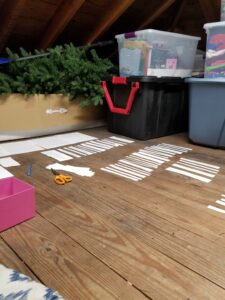With my first middle-grade novel ready to come out in the spring (RULE OF THREES! May 2021! From Chronicle!), I’m focusing on Novel #2 with a process that requires scissors, markers, and a retreat into my attic.
Writers often get asked about our “process.” Every writer has a different one, and writers might have different processes for different types of books (I do!). When a new writer asks me the process question, I always make sure to say there is no “one size fits all,” however, there’s nothing wrong with gathering a lot of how-tos and cobbling together a process that works for you.
I wrote a couple of failed novels (for adults) with a process that absolutely did not work for me. Then, I sat down and read a whole bunch of books on outlining, tried a few things, and eventually came up with the plan that led to RULE OF THREES and that I’m now using for HAPPY, INDIANA.
I’ve learned that I write best when I’ve done all the “thinking” ahead of time. I freewrite on my idea for many months, reading books on my topic, googling questions, etc. I also talk to people. In this case, I talked to people who grew up (or still live in) Indiana, since I don’t. This led to my going down a very interesting rabbit hole that has become an important subplot in the book.
Eventually, when I get to a point where I have way more notes than I know what to do with (in this case, about 80 single-spaced typed pages), I comb through looking for potential scenes, which I lay out in a new document with subheadings for the different sections of the book (for “sections” see Mary Kole’s excellent book, “Writing Irresistible Kidlit” which pretty much changed my life when it comes to developing plot).
THEN, and this is the part that is kind of next-level persnickety, I cut out each individual scene and color-code them according to major themes of the book. So, if the scene involves the protagonist’s parents’ divorce, I put a pink line across the corner. If it’s also about her love interest, I add a green line. Each major “element” gets a different color (I have seven in this book). I move the scenes around, reading and re-reading, until it seems like I can really see the flow of the book and it makes sense, one scene leading to the next (note: if you can just rearrange your scenes and the book still makes sense, then you don’t have a compelling plot). I learned this the hard way.
Because of the color-coding, I can see at a glance where elements might be falling off my radar, like, uh-oh, there isn’t any green for like 10 scenes, not good. Then, I’ll add another scene to take care of that.
Unfortunately, this process requires a great deal of space, and with my kids and husband all working from home (plus my three pets always under foot), I was forced into our attic where I at least had an empty few feet of floor. I spent many days up there, happily rearranging, but leaving the stairs down so I didn’t get trapped like Clark Griswold in Christmas Vacation (we have a very similar attic).
Once I’m happy, I collect all my scenes in order, type up a new outline and start writing! Writing is the easy part of this process! It feels weird to tell people the book is going great, that I’ll be done soon, when I’m literally writing chapter one. But that’s really how it goes for me. It’s all up here (points to head) and I’m just getting it down on paper. So excited for this book!